Influence of Varying Tensile Stress on Domain Motion
Abstract
:1. Introduction
2. Methodology
2.1. Domain Image Sensing and Domain Motion Characterization
2.2. Mechanism of Domain Motion and the Threshold Stress Value
2.3. Experimental Setup
3. Result and Discussion
3.1. Mechanism of Domain Motion in the Elastic and Plastic Range
3.2. The Proposed TSV and the Influential Factors
4. Conclusions and Future Work
Author Contributions
Funding
Conflicts of Interest
References
- Wang, Z.D.; Gu, Y.; Wang, Y.S. A review of three magnetic NDT technologies. J. Magn. Magn. Mater. 2012, 324, 382–388. [Google Scholar] [CrossRef]
- Liu, X.; Shang, W.; He, C.; Zhang, R.; Wu, B. Simultaneous quantitative prediction of tensile stress, surface hardness and case depth in medium carbon steel rods based on multifunctional magnetic testing techniques. Measurement 2018, 128, 455–463. [Google Scholar] [CrossRef]
- Chady, T.; Łukaszuk, R.D.; Gorący, K.; Żwir, M.J. Magnetic Recording Method (MRM) for Nondestructive Evaluation of Ferromagnetic Materials. Materials 2022, 15, 630. [Google Scholar] [CrossRef] [PubMed]
- Ding, S.; Tian, G.; Dobmann, G.; Wang, P. Analysis of domain wall dynamics based on skewness of magnetic Barkhausen noise for applied stress determination. J. Magn. Magn. Mater. 2017, 421, 225–229. [Google Scholar] [CrossRef] [Green Version]
- Fagan, P.; Ducharne, B.; Daniel, L.; Skarlatos, A.; Domenjoud, M.; Reboud, C. Effect of stress on the magnetic Barkhausen noise energy cycles: A route for stress evaluation in ferromagnetic materials. Mater. Sci. Eng. B 2022, 278, 115650. [Google Scholar] [CrossRef]
- Bajracharya, S.; Sasaki, E. Investigation of effect of stress on eddy current response using phase diagram. Struct. Infrastruct. Eng. 2020, 16, 1276–1285. [Google Scholar] [CrossRef]
- Qiu, F.; Ren, W.; Tian, G.Y.; Gao, B. Characterization of applied tensile stress using domain wall dynamic behavior of grain-oriented electrical steel. J. Magn. Magn. Mater. 2017, 432, 250–259. [Google Scholar] [CrossRef]
- Liu, J.; Tian, G.Y.; Gao, B.; Zeng, K.; Zheng, Y.; Chen, J. Micro-macro characteristics between domain wall motion and magnetic Barkhausen noise under tensile stress. J. Magn. Magn. Mater. 2019, 493, 165719. [Google Scholar] [CrossRef]
- Liu, J.; Tian, G.Y.; Gao, B.; Zeng, K.; Qiu, F. Domain wall characterization inside grain and around grain boundary under tensile stress. J. Magn. Magn. Mater. 2018, 471, 39–48. [Google Scholar] [CrossRef]
- Betz, B.; Rauscher, P.; Harti, R.P.; Schäfer, R.; Irastorza-Landa, A.; Van Swygenhoven, H.; Kaestner, A.; Hovind, J.; Pomjakushina, E.; Lehmann, E.; et al. Magnetization response of the bulk and supplementary magnetic domain structure in high-permeability steel laminations visualized in situ by neutron dark-field imaging. Phys. Rev. Appl. 2016, 6, 024023. [Google Scholar] [CrossRef] [Green Version]
- Cao, H.; Hao, L.; Yi, J.; Zhang, X.; Luo, Z.; Chen, S.; Li, R. The influence of punching process on residual stress and magnetic domain structure of non-oriented silicon steel. J. Magn. Magn. Mater. 2016, 406, 42–47. [Google Scholar] [CrossRef]
- Qiu, F.; Jovičević-Klug, M.; Tian, G.; Wu, G.; McCord, J. Correlation of magnetic field and stress-induced magnetic domain reorientation with Barkhausen Noise. J. Magn. Magn. Mater. 2021, 523, 167588. [Google Scholar] [CrossRef]
- Schäfer, R.; Soldatov, I.; Arai, S. Power frequency domain imaging on Goss-textured electrical steel. J. Magn. Magn. Mater. 2019, 474, 221–235. [Google Scholar] [CrossRef]
- Perevertov, O.; Schäfer, R. Magnetic properties and magnetic domain structure of grain-oriented Fe-3% Si steel under compression. Mater. Res. Express 2016, 3, 096103. [Google Scholar] [CrossRef]
- Gao, F.M.; Fan, J.C.; Zhao, K.P.; Li, D.H.; Bin Hu, Z. In situ observation of the magnetic domain in the process of ferroalloy friction. Tribol. Int. 2016, 97, 371–378. [Google Scholar] [CrossRef]
- Roskosz, M.; Bieniek, M. Evaluation of residual stress in ferromagnetic steels based on residual magnetic field measurements. NDT E Int. 2012, 45, 55–62. [Google Scholar] [CrossRef]
- Fu, M.L.; Bao, S.; Zhao, Z.Y.; Gu, Y.B. Effect of sample size on the residual magnetic field of ferromagnetic steel subjected to tensile stress. Insight-Non-Destr. Test. Cond. Monit. 2018, 60, 90–94. [Google Scholar] [CrossRef]
- Huang, H.; Qian, Z. Effect of temperature and stress on residual magnetic signals in ferromagnetic structural steel. IEEE Trans. Magn. 2016, 53, 6200108. [Google Scholar] [CrossRef]
- Han, G.; Huang, H. A dual-dipole model for stress concentration evaluation based on magnetic scalar potential analysis. NDT E Int. 2021, 118, 102394. [Google Scholar] [CrossRef]
- Shi, P. Magneto-elastoplastic coupling model of ferromagnetic material with plastic deformation under applied stress and magnetic fields. J. Magn. Magn. Mater. 2020, 512, 166980. [Google Scholar] [CrossRef]
- Liu, Y.; Xia, J.; Finkel, P.; Moss, S.D.; Liao, X.; Cairney, J.M. Real-time observation of stress-induced domain evolution in a [011] PIN-PMN-PT relaxor ferroelectric single crystal. Acta Mater. 2019, 175, 436–444. [Google Scholar] [CrossRef]
- Jakobsen, V.B.; Trzop, E.; Gavin, L.C.; Dobbelaar, E.; Chikara, S.; Ding, X.; Esien, K.; Müller-Bunz, H.; Felton, S.; Zapf, V.S.; et al. Stress-induced Domain Wall Motion in a Ferroelastic Mn3+ Spin Crossover Complex. Angew. Chem. 2020, 132, 13407–13414. [Google Scholar] [CrossRef]
- Mohamed, T. Emerging Nanotechnology Applications in Electrical Engineering; IGI Global: Hershey, PA, USA, 2021. [Google Scholar]
- You, W.; Pei, K.; Yang, L.; Li, X.; Shi, X.; Yu, X.; Guo, H.; Che, R. In situ dynamics response mechanism of the tunable length-diameter ratio nanochains for excellent microwave absorber. Nano Res. 2020, 13, 72–78. [Google Scholar] [CrossRef]
- Bryan, M.T.; Dean, J.; Allwood, D.A. Dynamics of stress-induced domain wall motion. Phys. Rev. B 2012, 85, 144411. [Google Scholar] [CrossRef]
- McCord, J. Progress in magnetic domain observation by advanced magneto-optical microscopy. J. Phys. D Appl. Phys. 2015, 48, 333001. [Google Scholar] [CrossRef]
- Zeng, K.; Tian, G.; Liu, J.; Gao, B.; Qiu, F. Repeatability and stability study of residual magnetic field for domain wall characterization. J. Magn. Magn. Mater. 2019, 485, 391–400. [Google Scholar] [CrossRef]
- Jiles, D.C. Theory of the magnetomechanical effect. J. Phys. D Appl. Phys. 1995, 28, 1537. [Google Scholar] [CrossRef]
- Shi, P. Magneto-mechanical model of ferromagnetic material under a constant weak magnetic field via analytical anhysteresis solution. J. Appl. Phys. 2020, 128, 115102. [Google Scholar] [CrossRef]
- Shi, P.; Jin, K.; Zheng, X. A general nonlinear magnetomechanical model for ferromagnetic materials under a constant weak magnetic field. J. Appl. Phys. 2016, 119, 145103. [Google Scholar] [CrossRef]

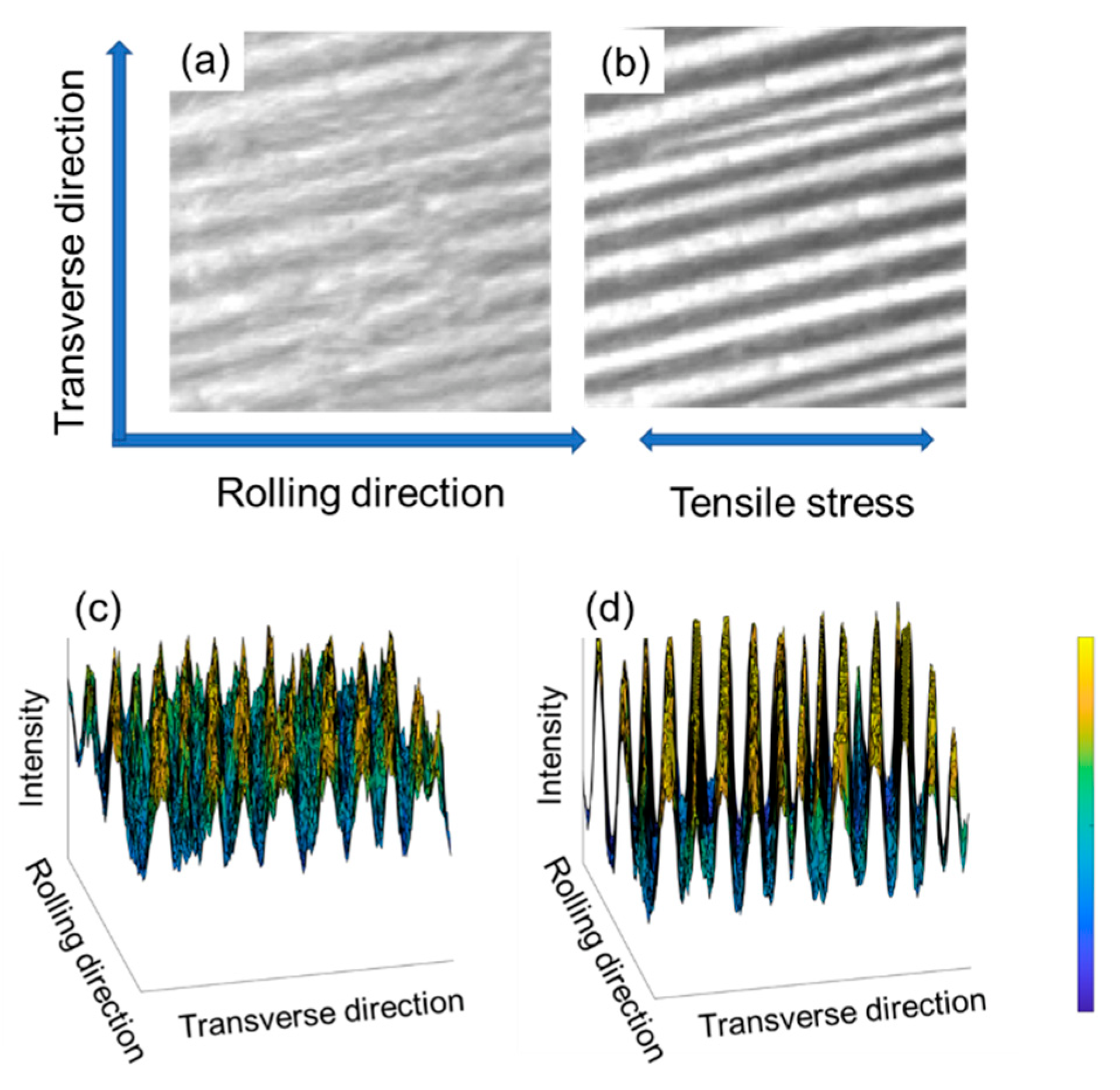

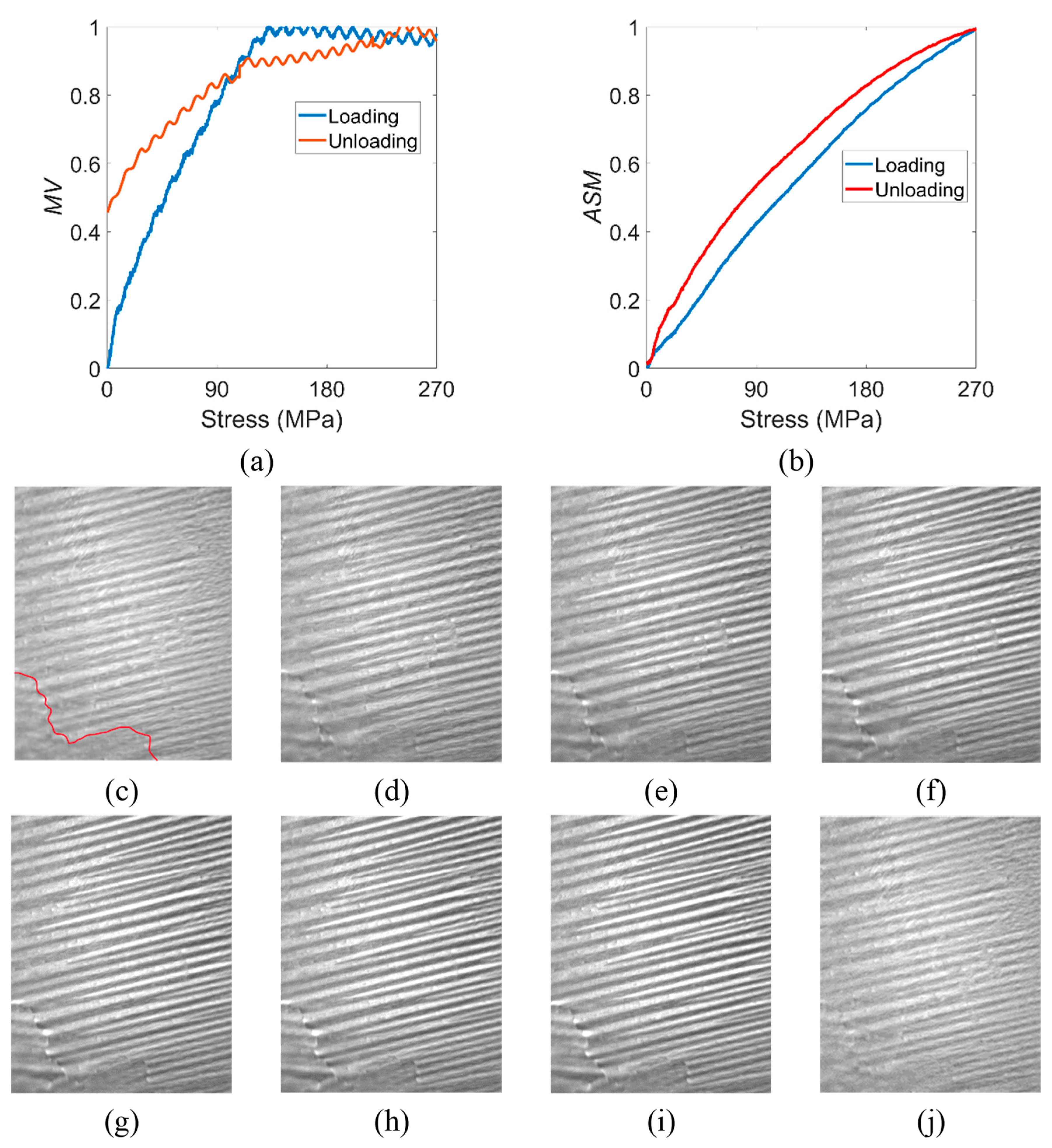
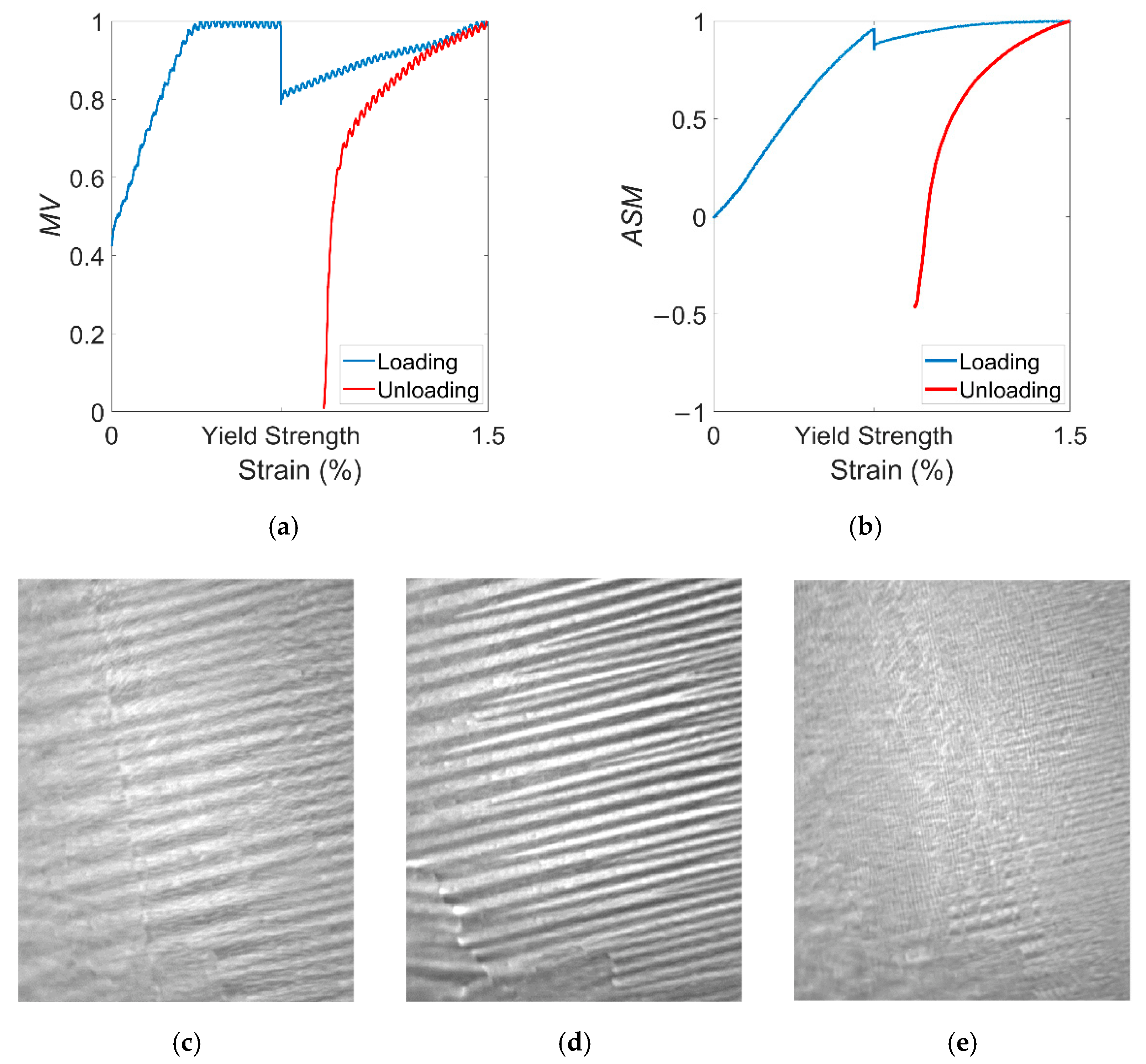
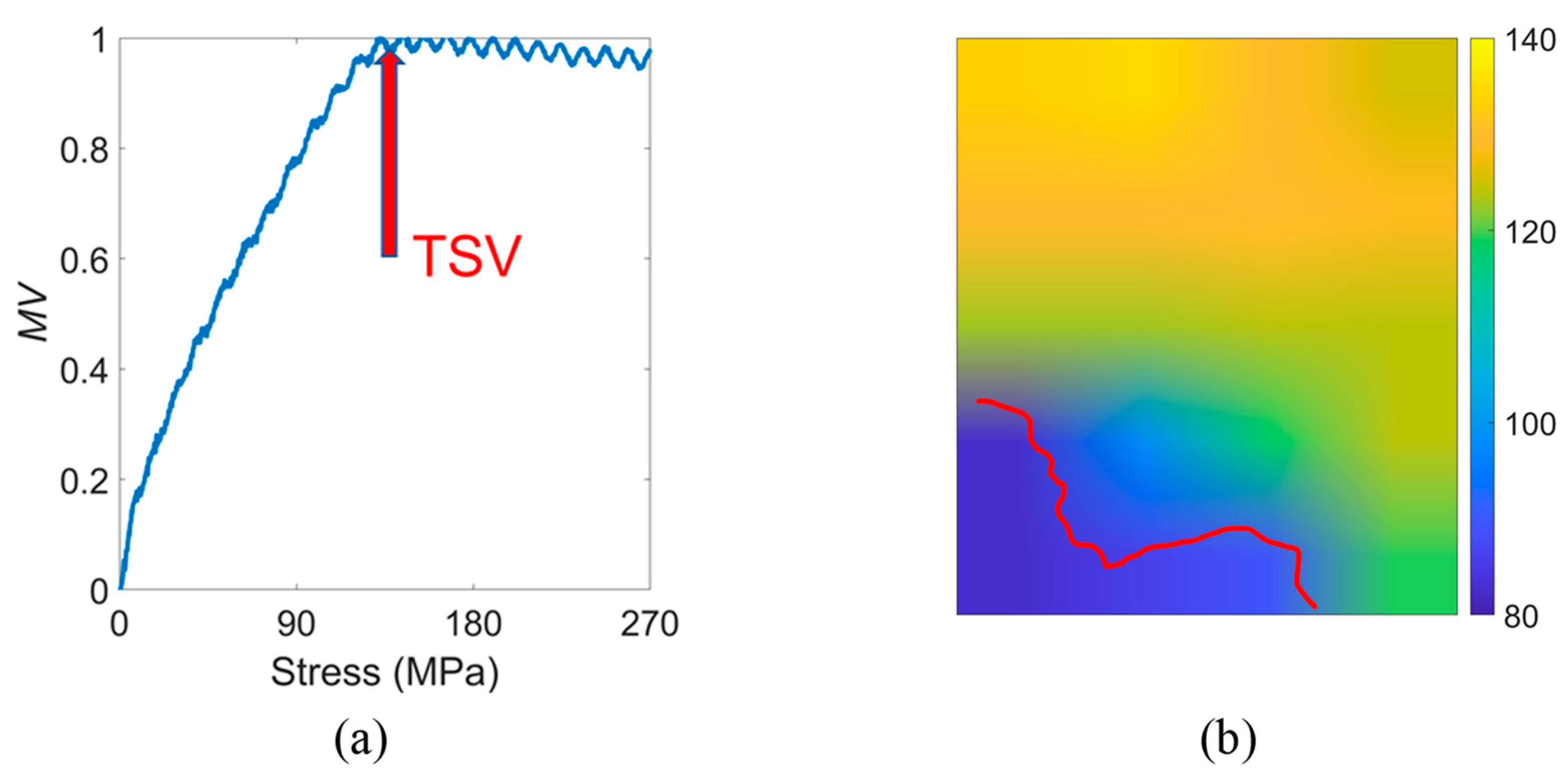
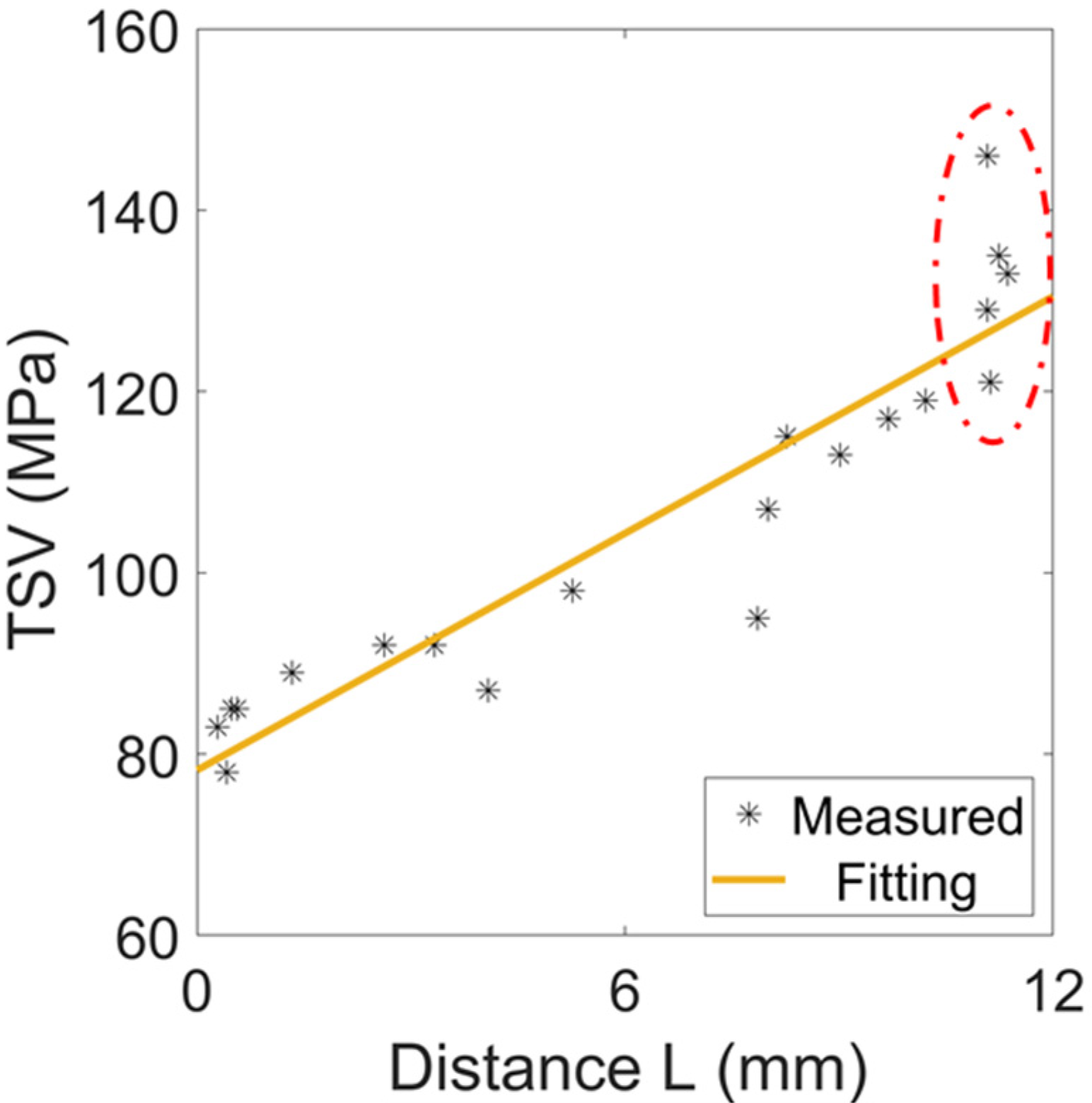

| Fe | Si | C | Mn | P | S | Al |
|---|---|---|---|---|---|---|
| Balance | 3.00–5.00 | 0.06 | 0.15 | 0.03 | 0.25 | 5.10–8.50 |
| Domain Images | TSV | Distance L | Average Domain Width | Domain Orientation |
|---|---|---|---|---|
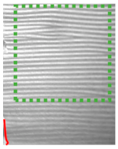 | 121 MPa | 11.08 mm | 0.263 mm | 0° |
 | 128 MPa | 11.13 mm | 0.435 mm | 0° |
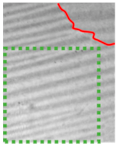 | 133 MPa | 11.24 mm | 0.566 mm | 11° |
 | 135 MPa | 11.36 mm | 0.910 mm | 10° |
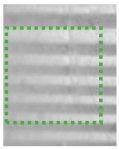 | 146 MPa | 11.08 mm | 1.111 mm | −2° |
Publisher’s Note: MDPI stays neutral with regard to jurisdictional claims in published maps and institutional affiliations. |
© 2022 by the authors. Licensee MDPI, Basel, Switzerland. This article is an open access article distributed under the terms and conditions of the Creative Commons Attribution (CC BY) license (https://creativecommons.org/licenses/by/4.0/).
Share and Cite
Zeng, K.; Tian, G.; Liu, J.; Gao, B.; Liu, Y.; Liu, Q. Influence of Varying Tensile Stress on Domain Motion. Materials 2022, 15, 3399. https://doi.org/10.3390/ma15093399
Zeng K, Tian G, Liu J, Gao B, Liu Y, Liu Q. Influence of Varying Tensile Stress on Domain Motion. Materials. 2022; 15(9):3399. https://doi.org/10.3390/ma15093399
Chicago/Turabian StyleZeng, Kun, Guiyun Tian, Jia Liu, Bin Gao, Yi Liu, and Qianhang Liu. 2022. "Influence of Varying Tensile Stress on Domain Motion" Materials 15, no. 9: 3399. https://doi.org/10.3390/ma15093399
APA StyleZeng, K., Tian, G., Liu, J., Gao, B., Liu, Y., & Liu, Q. (2022). Influence of Varying Tensile Stress on Domain Motion. Materials, 15(9), 3399. https://doi.org/10.3390/ma15093399








